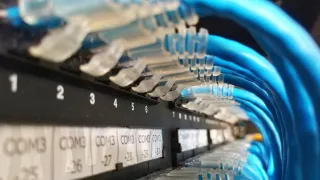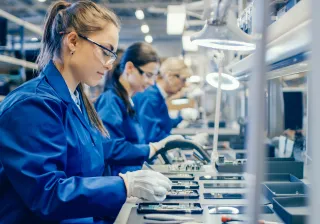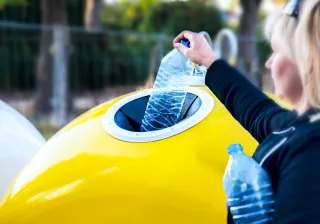Nobody knows precisely where high-value materials are, who owns them and how they are being used right now. This is a big problem for the circular economy. Developing the monitoring of materials represents a fantastic business opportunity for companies.
VTT's future outlook combines data and materials in a way that makes materials identifiable and traceable.
"Information is absolutely critical to the circular economy. We need to know where materials are. Without this information, many important steps forward will not be taken," says Matti Tähtinen, Senior Scientist at VTT.
The list of information required by the circular economy is long.
"We need information about the products that can be recycled. In addition to the location of the products, it is also essential to know about the materials they contain. The manufacturer has this information, but the vendor or user does not necessarily have it," says Ville Kotovirta, Senior Scientist.
In the ideal scenario, the product itself would contain information about the materials used to make it. Clothes already have labels saying which fibres they are made from. Products have also become more traceable thanks to RFID tags.
However, many industrial products contain dozens of different materials. If the information on materials is incomplete, many valuable materials will inevitably be wasted.
"Information should become an integral part of products, components and materials. It sounds complicated, and indeed it is," says Géza Szilvay, Senior Scientist at VTT.
"Micro-scale tags are already in use for identifying products and preventing forgeries. These can be found in items such as banknotes. But if we are thinking about individual components and materials, the technical solutions become considerably more complex."
VTT is already researching how data could be written to and read from materials. The solutions being studied are on the molecular level.
"We are studying how the periodicity of molecular structures can be managed and whether there are any practical ways of reading this data. We also want to utilise biochemical structures, such as the onset of different microstructures as a function of time, and identify suitable methods for reading them. We aim to utilise this research in concepts that companies will eventually be able to use to monitor materials," says Szilvay.
Real-time data is needed soon
It would be a great achievement to incorporate material data into materials, but that alone will not be enough.
"We need real-time information on material flows very soon. For example, the need for lithium will continue to grow. It is vital to get it back into circulation because lithium is needed to store solar and wind energy and make batteries for electric cars," says VTT's Research Scientist, Vafa Järnefelt.
Real-time monitoring can succeed if products, components and materials are able to communicate and work as a part of the industrial internet. Then the data they contain could be stored on various cloud services. Anybody would be able to find out where high-value materials are, who owns them and at which stage of lifecycle they are and directed for recirculation.
The impact would be transformative.
"Data mobility is a prerequisite for markets to arise. When data about materials becomes open, market information is available to everyone, and the market can assess a price for the materials. The data also has an intrinsic value because it affects the trade in materials. Someone will surely have an interest in digging up this data. Data related to the circular economy could, therefore, give rise to a data market that motivates companies and people to share data and accelerates the growth of the circular economy," Ville Kotovirta forecasts.
VTT is building a circular economy project aiming to accelerate the circulation of products and materials by generating and sharing knowledge. A corporate consortium is currently being assembled, and companies are being invited to join the project.
Material as-a-service
A further crucial aspect is data related to material ownership.
"The problem with the linear economy is that the responsibility for products and materials is cut off after the purchase transaction. The new owner decides how the product or material is used, for how long the products or material stays in circulation or how fast it's being disposed of. If the material is not connected to ownership, nobody cares about it. For instance, consumables owned by consumers are so called loose-end products (consisting valuable materials) that are lost during their lifecycle. Someone needs to care about materials in order to get them back into circulation. Tracing technologies make this possible," Vafa Järnefelt says.
If we know who owns a material, purchase offers can be made, even if the quantities are small. A financial incentive makes recycling feel even more worthwhile. At present, the mobile phones, computers and tablets owned by Finnish people contain lithium amounting to about as much as a packet of ham.
It is also possible for companies to begin selling the right to use materials as a service. Conventional metal industry companies may become such service providers, but any new operator could step in just as easily.
"Anyone who finds value in a material will ensure that it is put back in use and remains in circulation for as long as possible," Järnefelt says.
Markets bring about systematic change
Combining data with material circulation requires major systematic changes. Whose job is it to promote change?
"Everyone who wants to create new business and growth," replies Ville Kotovirta.
"Systematic change arises when markets change. There is already a demand for more sustainable solutions and, conversely, the desirability of unsustainable solutions will decrease over a period of time. It may not be necessary for a regulator to say how things must be done. The regulator creates a framework in which to operate but, ultimately, the markets bring about change. There is already a global trade in recycled materials, even though no-one is regulating it."
In Matti Tähtinen's opinion, developing the monitoring of materials represents a fantastic business opportunity for Finnish companies.
"This is a totally scalable business model. If it can be made to work in Finland, the solution could be taken anywhere in the world."
VTT is building a circular economy project aiming to accelerate the circulation of products and materials by generating and sharing knowledge. A corporate consortium is currently being assembled, and companies are being invited to join the project.










